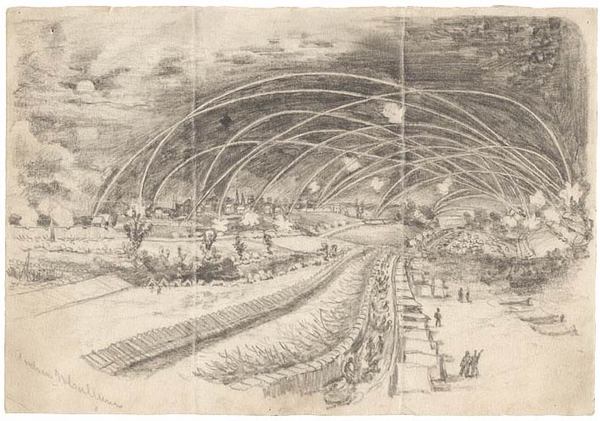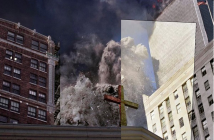It's no secret that our culture is fixated on war. The United States has been in some form of war, cold or hot, since before my parents were born. As I write this, we are in the midst of two wars, and there are some politicians <who?>clamoring for a third. War dominates our political discourse, our entertainment, and our imagery. It is something that our culture continues to try to understand, to make meaning from, and to experience in a visual way.
This is why First Hand: Civil War Era Drawings from the Becker Collection is such a powerful show. These drawings, by twelve artists who stood on the battlefields and watched the horrors of war, show us both an artistry of emotion and a complexity of experience that we do not often find in war imagery. These drawings are rendered doubly powerful by the fact that they were made during a time when photography was coming into its own as a representative medium, and they are the last of a type of image record that was eclipsed even in their own time.
The exhibition is the result of several years work, beginning with Boston College professor and artist Sheila Gallagher, a descendant of Joseph Becker who inherited the collection of drawings. Becker was the art director for Leslie's Illustrated Newspaper, a Civil War era journal that told stories of the war accompanied by etchings. These illustrations were based on field drawings by a number of artists, including Becker, who traveled with the army and drew the battles, or visited the sites later to make sketches of the aftermath. While Alfred Waud and many other battlefield artists have gained historical prominence, the artists of the Becker collection have been lost to history until recently, when Gallagher teamed up with BC art historian Judith Bookbinder to archive and exhibit the work.
There are many intense drawings in the exhibition, showing the actual battles and consequences of war. Andrew McCallum's Siege of Petersburg: A Night Attack, March 31, 1865 offers a poetically cyclical image, the white arcs of the cannon shells form snaking tendrils above the trenches below. Similarly, John F. E. Hillen's Battle Two Miles West Of Atlanta, July 30, 1864 offers a stark vertical format, framed by dark trees that part to reveal a fence-line, and the Confederate lines beyond.
One of the most incredible and demanding illustrations in the exhibition is by Henri Lovie, titled Battle of Shiloh or Pittsburg Landing, Tennessee: Centre; Sunday Morning, April 6, 1862. The average reader of the day would have known that the Battle of Shiloh was an incredibly chaotic battle, with the Union falling back in near-defeat before rallying behind a small group of brave men along a sunken road. Even without this knowledge of the battle, anyone can appreciate the chaos of the scene that Lovie depicts, as men and horses tumble over each other in an effort to escape the looming battle lines behind them. Soldiers jump over the dead horses in the foreground, the fear visible on their faces, as shells explode and shatter the trees overhead. The whole piece is reminiscent of a painting of Napoleon's defeat at Waterloo.
No photograph of the era ever came this close to capturing this vision of battle. Author George Sullivan1 points out that of all the images made during the Civil War, there is only one photograph of soldiers under fire, taken during the second attack on Fredericksburg during the Battle of Chancellorsville. All of the images captured by Brady, O'Sullivan, Gardner and the others show the aftermath of the battle, but the Becker Collection gives us powerful scenes from the moment, the artists standing among the terrified men, furiously sketching on a scrap of paper as the frightened horses pass.
There are other images in the exhibition as well, taken from later stories showing the growth of antebellum America. Two images by Joseph Becker offer views of a group of Shakers in a meeting hall, and Chinese workers building a railroad. While the immediacy of war is missing in these drawings, the artist's eye captures a moment in time that would have been lost to us forever, save for his pencil.
First Hand: Civil War Era Drawings from the Becker Collection is an exhibition of numerous drawings that convey a sense of power, history and emotion. Even for those who are uninterested in the Civil War or unconcerned with history, they are beautiful and engaging works of art. They are the last, fading images of a time before photography dominated our visual culture, and show how our predecessors came to understand the world, especially the world at war, in this era of radical social, political and artistic change.
[1] - George Sullivan, In The Wake Of Battle: The Civil War Images Of Matthew Brady, Prestel
The McMullen Museum of Art at Boston College
"First Hand: Civil War Era Drawings from the Becker Collection" is on view September 5 through December 13, 2009 at The McMullen Museum.
All images are courtesy of The McMullen Museum website.



